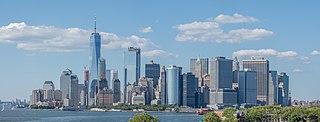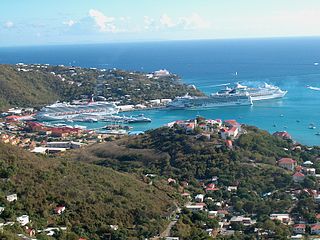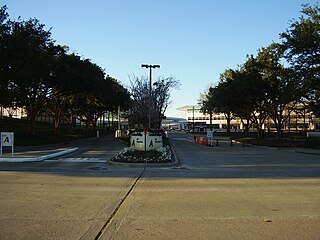Related Research Articles

The Economy of Switzerland is one of the world's most advanced and a highly-developed free market economy. The economy of Switzerland has ranked first in the world since 2015 on the Global Innovation Index and third in the 2020 Global Competitiveness Report. According to United Nations data for 2016, Switzerland is the third richest landlocked country in the world after Liechtenstein and Luxembourg. Together with the latter and Norway, they are the only three countries in the world with a GDP per capita (nominal) above US$90,000 that are neither island nations nor ministates. Among OECD nations, Switzerland has a highly efficient and strong social security system; social expenditure stood at roughly 24.1% of GDP.

The United States is a highly developed/advanced mixed economy. It is the world's largest economy by nominal GDP; it is also the second largest by purchasing power parity (PPP), behind China. It has the world's sixth highest per capita GDP (nominal) and the eighth highest per capita GDP (PPP) as of 2024. The U.S. accounted for 26% of the global economy in 2023 in nominal terms, and about 15.5% in PPP terms. The U.S. dollar is the currency of record most used in international transactions and is the world's reserve currency, backed by a large U.S. treasuries market, its role as the reference standard for the petrodollar system, and its linked eurodollar. Several countries use it as their official currency and in others it is the de facto currency. Since the end of World War II, the economy has achieved relatively steady growth, low unemployment and inflation, and rapid advances in technology.

The economy of the United States Virgin Islands is primarily dependent upon tourism, trade, and other services, accounting for nearly 60% of the Virgin Island's GDP and about half of total civilian employment. Close to two million tourists per year visit the islands. The government is the single largest employer. The agriculture sector is small, with most food being imported. The manufacturing sector consists of rum distilling, electronics, pharmaceuticals, and watch assembly. Rum production is significant. Shipments during a six-month period of fiscal year 2016 totaled 8,136.6 million proof gallons.

Metro Detroit is a major metropolitan area in the U.S. state of Michigan, consisting of the city of Detroit and over 200 municipalities in the surrounding area with its largest employer being Oakland County. There are varied definitions of the area, including the official statistical areas designated by the Office of Management and Budget, a federal agency of the United States.

Greater St. Louis is the 21st-largest metropolitan statistical area (MSA) in the United States, the largest in Missouri, and the second-largest in Illinois. Its core city—St. Louis, Missouri—sits in the geographic center of the metro area, on the west bank of the Mississippi River. The river bisects the metro area geographically between Illinois and Missouri, although the latter portion is much more populous. The MSA includes St. Louis County, which is independent of the City of St. Louis; their two populations are generally tabulated separately.

The economy of Illinois is the fifth largest by GDP in the United States and one of the most diversified economies in the world. Fueled by the economy of Chicago, the Chicago metropolitan area is home to many of the United States' largest companies, including Abbott Laboratories, AbbVie Inc., Allstate, Baxter International, Conagra, Crate and Barrel, Kraft Heinz, McDonald's, CNH Industrial, GE Healthcare, Aon PLC, Willis Towers Watson, Mondelez International, Motorola, United Airlines, US Foods, Walgreens, and more. The Chicago area is a global financial center and headquarters a wide variety of financial institutions including Citadel LLC, CNA Financial, Discover Financial Services, Morningstar, Inc., Nuveen, and more. Chicago is also home to the largest futures exchange in the world, the Chicago Mercantile Exchange.

Ziyang prefecture-level city in eastern Sichuan province, China. It is bordered by the provincial capital of Chengdu to the northwest, Deyang to the north, Suining to the northeast, Chongqing municipality to the east, and Neijiang to the west. Its development is going to be very important because of the proximity of Chengdu new Airport and economic zone. As of the 2020 Chinese census, Ziyang's total population was 2,308,631 inhabitants whom 867,119 lived in the built-up area made of Yanjiang District.

The Memphis–Clarksdale-Forrest City Combined Statistical Area, TN–MS–AR (CSA) is the commercial and cultural hub of the Mid-South or Ark-Miss-Tenn. The census-defined combined statistical area covers eleven counties in three states, Tennessee, Mississippi, and Arkansas. As of 2020 census, the Memphis metropolitan area had a population of 1,389,905 The Forrest City, Arkansas Micropolitan area was added to the Memphis area in 2012 to form the Memphis–Forrest City Combined Statistical area. In 2023 the Clarksdale, Mississippi Micropolitan area was also added to form the new Memphis-Clarksdale-Forrest City Combined Statistical Area which as of 2023 had a population of roughly 1.4 million people according to census estimates.

The economy ofHouston is based primarily on the energy industry, particularly oil. However, health care, biomedical research, and aerospace also constitute large sectors. In 2021, the gross domestic product (GDP) of the Houston–The Woodlands–Sugar Land metropolitan statistical area (MSA) was 537 U.S. dollars billion, the fourth-largest of any metro area in the United States. The Houston metropolitan area comprises the largest concentration of petrochemical manufacturing in the world, including for synthetic rubber, insecticides, and fertilizers. It is the world's leading center for oilfield equipment construction, with the city of Houston home to more than 3,000 energy-related businesses, including many of the top oil and gas exploration and production firms and petroleum pipeline operators. As of 2011, 23 companies on the Fortune 500 list have their headquarters in, or around, Houston.

The economy of the Commonwealth of Virginia is well balanced with diverse sources of income. From the Hampton Roads area to Richmond and down to Lee County in the southwest includes military installations, cattle, tobacco and peanut farming in Southside Virginia. Tomatoes recently surpassed soy as the most profitable crop in Virginia. Tobacco, peanuts and hay are also important agricultural products from the commonwealth. Wineries and vineyards in the Northern Neck and along the Blue Ridge Mountains also have become increasingly popular. Northern Virginia hosts software, communications, consulting, defense contracting, diplomats, and considerable components of the professional government sector. As of the 2000 census, Virginia had the highest number of counties and independent cities (15) in the top 100 wealthiest jurisdictions in the United States based upon median income, in addition, Virginia tied with Colorado as having the most counties (10) in the top 100 based on per capita income. Loudoun and Fairfax counties in Northern Virginia have the highest and second highest median household income, respectively, of all counties in the United States as of 2017.
Located on the Mississippi River, the metropolitan area of Memphis is one of the largest in the Southeastern United States, ranking 42nd in the United States according to the 2010 census. The city has historically been one of the largest shipping hubs in the Mid-South, dating back to the Civil War, when the port was one of the largest on the Mississippi River and served as a shipping hub for the Confederacy.

The economy of Ohio nominally would be the 20th largest global economy behind Turkey and ahead of Switzerland according to The World Bank as of 2022. The state had a GDP of $822.67 billion in 2022, which is 3.23% of the United States total, ranking 7th in the nation behind Pennsylvania and ahead of Georgia. In 2013, Ohio was ranked in the top ten states for best business climate by Site Selection magazine, based on a business-activity database. The state was edged out only by Texas and Nebraska for the 2013 Governor's Cup award from the magazine, based on business growth and economic development.
Pakistan's industrial sector accounts for 28.11% of the GDP. Of this, manufacturing makes up 12.52%, mining constitutes 2.18%, construction makes up 2.05%, and electricity and gas 1.36%. The majority of industry is made up of textile units, with textiles contributing $15.4b to exports, making up 56% of total exports. Other units include surgical instruments, chemicals, and a budding automotive industry. Pakistan's inadequately developed labor market, unable to absorb the increasing number of educated workers, has resulted in a high rate of unemployment among graduates.
The total gross state product for Connecticut for 2012 was $229.3 billion, up from $225.4 billion in 2011.

The economy of the state of Indiana is reflected in its gross state product in 2017 of US$359 billion and per capita income of $44,165. A high percentage of Indiana's income is from manufacturing. Indiana has been the largest steel producing state in the U.S. since 1975, with the Calumet Region of northwest Indiana being the largest single steel producing area in the U.S., accounting for 27% of all U.S. steel production. Indiana is also the 2nd largest auto manufacturing state. Indiana's other manufactures include pharmaceuticals and medical devices, automobiles, electrical equipment, transportation equipment, chemical products, rubber, petroleum and coal products, and factory machinery.

The economy of Oklahoma is the 29th largest in the United States. Oklahoma's gross state product (GSP) is approximately $197.2 billion as of December 2018.

Manufacturing is a vital economic sector in the United States of America. The United States is the world's second-largest manufacturer after the People's Republic of China with a record high real output in 2021 of $2.5 trillion.

Philadelphia is the center of economic activity in both Pennsylvania and the four-state Delaware Valley metropolitan region of the United States. Philadelphia's close geographical and transportation connections to other large metropolitan economies along the Eastern Seaboard of the United States have been cited as offering a significant competitive advantage for business creation and entrepreneurship. Five Fortune 500 companies are headquartered in the city. As of 2021, the Philadelphia metropolitan area was estimated to produce a gross metropolitan product (GMP) of US$479 billion, an increase from the $445 billion calculated by the Bureau of Economic Analysis for 2017, representing the ninth largest U.S. metropolitan economy. Philadelphia was rated by the GaWC as a 'Beta' city in its 2016 ranking of world cities.

The economy of Greater Cleveland is diverse, but is based on healthcare, banking, finance, education, insurance, manufacturing, sports, and tech. The metropolitan area based in Cleveland is the 33rd largest in the country, and is home to over 2 million people.
The economy of Indianapolis is centered on the City of Indianapolis and Marion County within the context of the larger Indianapolis metropolitan area. The Indianapolis–Carmel–Anderson, IN MSA, had a gross domestic product (GDP) of $134 billion in 2015. The top five industries were: finance, insurance, real estate, rental, and leasing ($30.7B), manufacturing ($30.1B), professional and business services ($14.3B), educational services, health care, and social assistance ($10.8B), and wholesale trade ($8.1B). Government, if it had been a private industry, would have ranked fifth, generating $10.2 billion.
References
- ↑ "GDP by county" (PDF). Bureau of Economic Analysis. Retrieved July 26, 2023.
- ↑ "MARKETBEAT ST. LOUIS Office Q2 2023" (PDF). Cushman and Wakefield. Retrieved July 26, 2023.
- ↑ "SEGREGATION IN ST. LOUIS: DISMANTLING THE DIVIDE" (PDF). Arch city defenders. Retrieved July 26, 2023.
- ↑ "CAGDP1 Gross Domestic Product (GDP) summary by county and metropolitan area". Bureau of Economic Analysis. Archived from the original on 2020-03-15. Retrieved 2021-02-16.
- ↑ "CAGDP1 Gross Domestic Product (GDP) summary by county and metropolitan area". Bureau of Economic Analysis. Retrieved 2021-02-16.
- ↑ Bureau, US Census. "Manufacturing (NAICS Sector 31-33)". The United States Census Bureau. Archived from the original on 2020-04-06. Retrieved 2021-02-16.
- ↑ "Labor Force Data by County June 2012-July 2013". Bureau of Labor Statistics. September 20, 2013. Retrieved October 11, 2013.
- ↑ David Nicklaus (July 1, 2014). "Metro St. Louis adds 5,300 jobs in May". St. Louis Post-Dispatch .
- ↑ "Ikea seen as boost to St. Louis central corridor". St. Louis Post-Dispatch . June 29, 2014.
- ↑ "IKEA breaks ground on Swedish retailer's future St. Louis store, opening Fall 2015, as expansion in Midwestern U.S. continues". IKEA.com. June 24, 2014.
- ↑ "IKEA St. Louis Homepage". IKEA.com. Retrieved July 5, 2014.
- ↑ "River Transportation through and to St. Louis". St. Louis Commerce Magazine. 2005. Archived from the original on 2008-07-04. Retrieved 2009-10-04.
- ↑ "Archived copy" (PDF). Archived from the original (PDF) on 2014-06-29. Retrieved 2014-01-28.
{{cite web}}: CS1 maint: archived copy as title (link) - ↑ "Fortune 500". Fortune. Retrieved 2021-02-17.